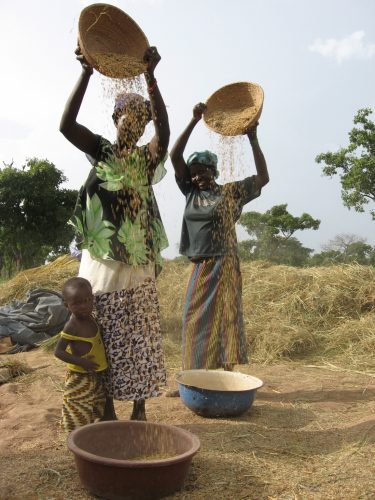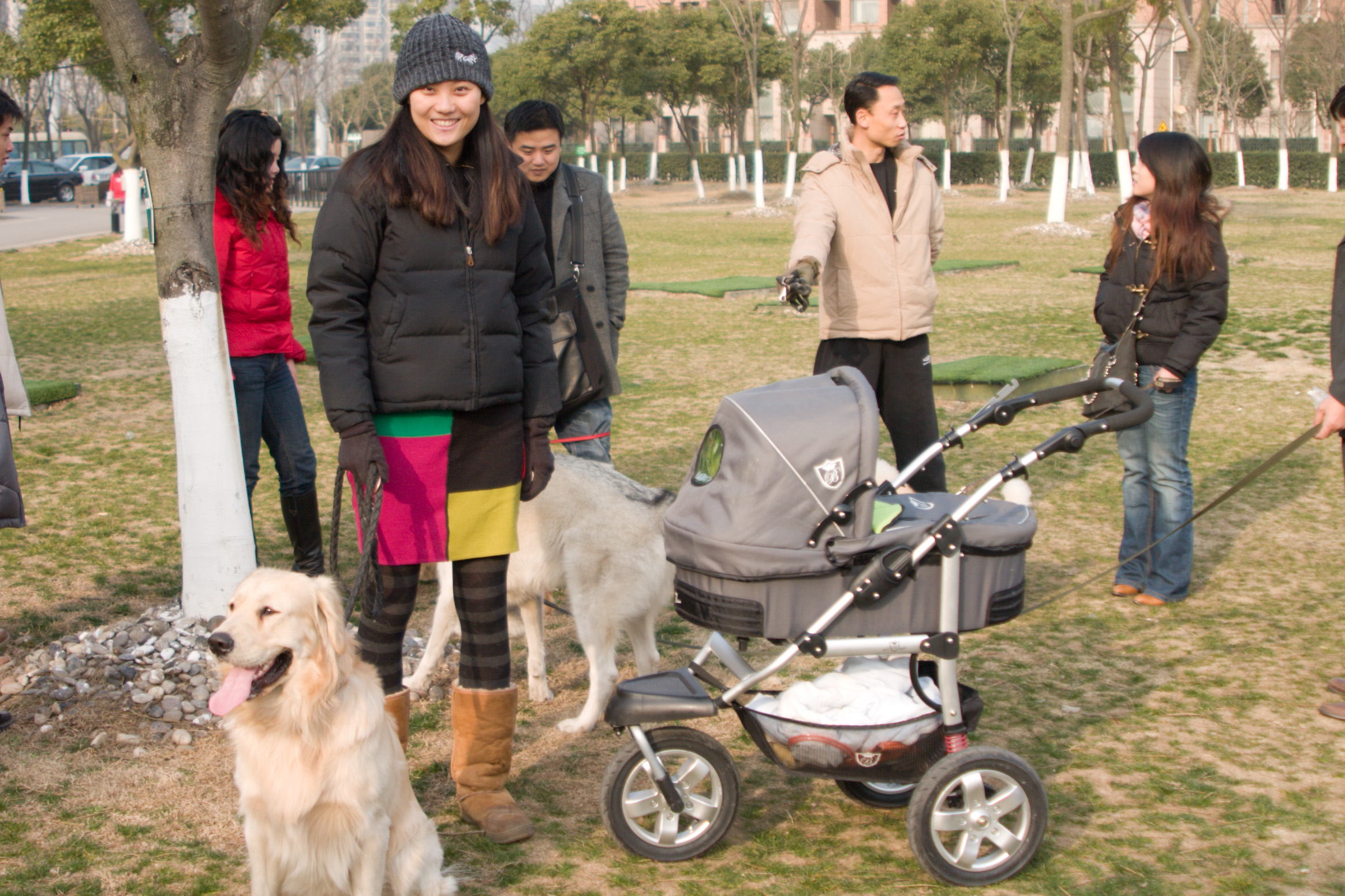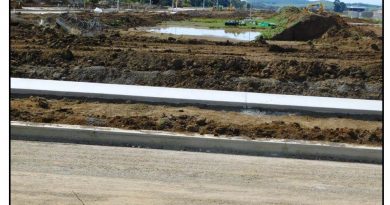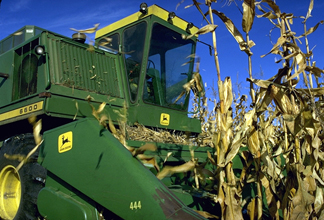World livestock an asset not a threat to human food availability
By Patrick Francis
Livestock production is generally positive for human food supply, nutrition and environmental protection in the era of climate change. That’s the take home message from an extensive investigation by researchers at the Food and Agriculture Organisation of the United Nations and the Animal Production Systems Group, Wageningen University, The Netherlands.
In the paper “Livestock: On our plates or eating at our table? A new analysis of the feed/food debate” by Anne Mottet et al published in Global Food Security (2017) the researchers have taken a far wider perspective than is commonly undertaken by groups opposed to feeding grain to livestock.
Even with the broad assumptions taken by the researchers to model all classes of livestock feed intake in developing (non OECD) countries and developed (OECD) countries, the overall conclusion suggests that livestock are not a significant competitor for grains. That because most of the feed they eat is not what humans eat.
“Results estimate that livestock consume 6 billion tonnes of feed (dry matter) annually – including one third of global cereal production – of which 86% is made of materials that are currently not eaten by humans. In addition, soybean cakes, which production can be considered as main driver or land-use, represent 4% of the global livestock feed intake. Producing 1 kg of boneless meat requires an average of 2.8 kg human-edible feed in ruminant systems and 3.2 kg in monogastric systems.”
Figure 1: Most of the world’s ruminant livestock are bred, grown and finished on pasture. Photo: Patrick Francis.
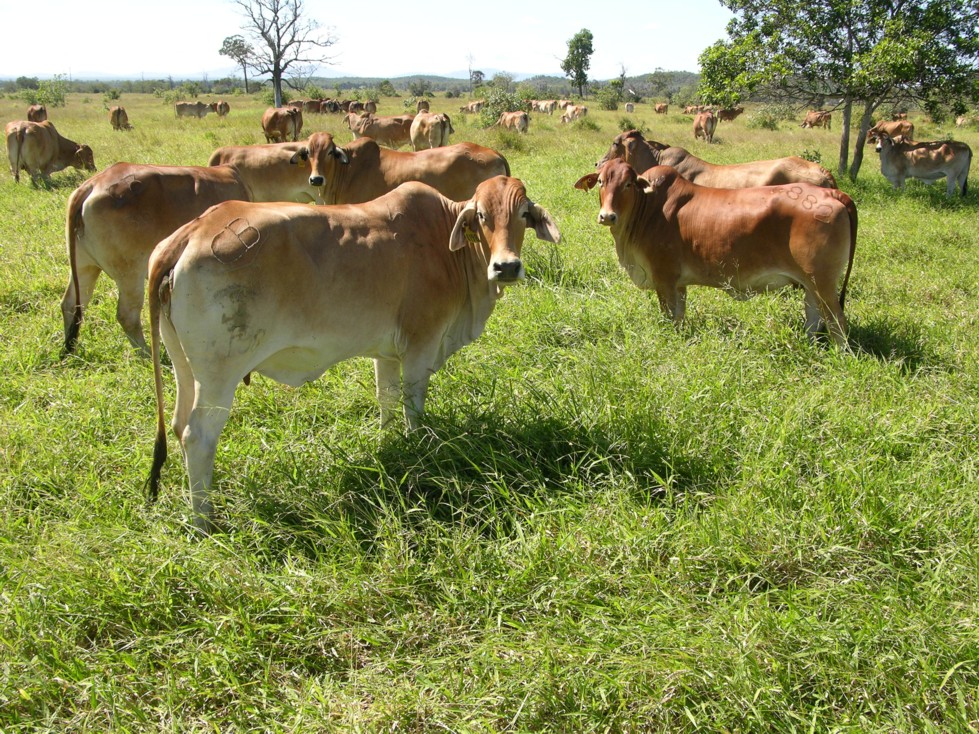
Data can be misleading
Closer investigation of the modelling used reveals the analysis is a coarse tool which doesn’t explain the variable nature of livestock production at a regional level, let alone what groups and individual farmers are feeding their livestock. For instance, the researchers do not reveal that in Australia most beef cattle and sheep are reared on pasture alone and most are never fed grains or bi-products. While lotfeeding to finish beef cattle and lambs on predominantly grain and bi-products is a significant industry here, using data which averages total feed consumed over total numbers of animals present is misleading. An increasing number of Australian beef and lamb farmers are associating their production systems with quality assurance programs that verify their commitment to pasture based livestock farming.
Table 1 from the modelling uses such coarse data that averages feed consumption (kilograms of dry matter per animal per year) across all livestock categories in non-OECD and OECD countries. It shows every class of ruminant is being fed some grain.
Table 1: Global livestock feed rations by regions, species and systems (kg DM/animal/year.
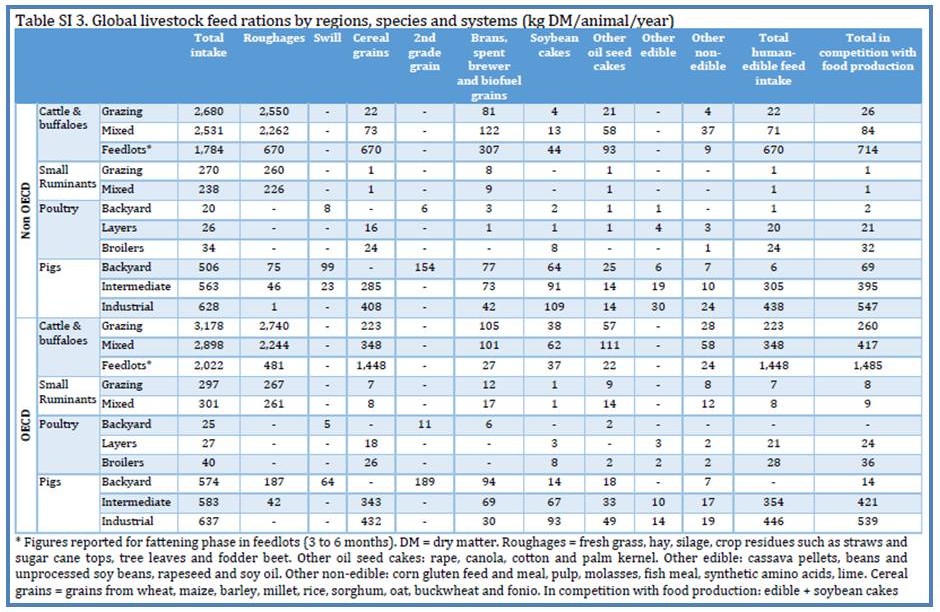
Table 2 is selected from the report to demonstrate the data about beef cattle feed consumption in different geographic regions of the world. Australia is the major livestock farming nation in Oceania yet the casual observer of the data would conclude that all beef cattle (and sheep) consume some cereal grains (13.7% of their dry matter intake) each year. That is wrong for beef cattle and sheep on many Australian farms.
Table 2: Beef cattle feed rations, regional averages.
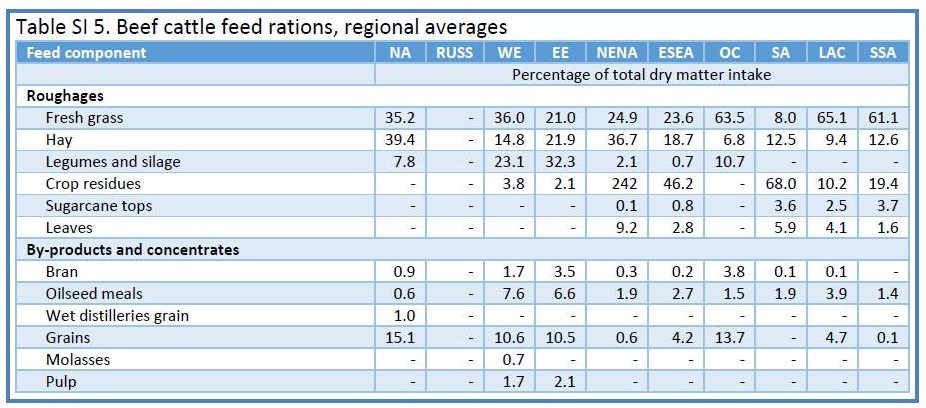
Despite this shortcoming the analysis is one of the first to highlight two critical points about ruminant livestock – sheep, cattle, goats:
• These animals are predominantly grown around the world on pasture and pasture based products such as hay, silage and stubbles; and
• They consume many bi-products from the human food processing chain that have potential to be environmental pollutants if not eaten.
“Beef production, in particular, is often criticized for its very high consumption of grain, with cited figures varying between 6 kg and 20 kg of grain per kg of beef produced. The upper bound of this range is, however, based on feedlot beef production, which accounts for 7% of global beef output according to Gerber et al. (2015) and FAO (2009), and 13% according to this analysis. It does not apply to the other forms of beef production that produce the remaining 87–93% of beef. Indeed, debate on the subject often lacks recognition of the wide diversity in production systems and in the goods and services delivered by livestock.
“Monogastric livestock, (pigs and poultry) consume very little roughage and compete more than ruminants for higher quality grains that humans can also eat.
“The literature often highlights the supposed efficiency of pigs and poultry in converting feed into meat. But these studies do not take account of the higher share of feed consumed in the form of grains edible by humans and of land suitable for food production used by monogastrics.
“Monogastric animals can only digest simple carbohydrates, and therefore consume low amounts of roughage. They, however, use larger quantities of grains and agricultural co- and by-products. In industrial broilers and layers, and in pig production, grains contribute more than 50% of total DM intake, while oil seed cakes range from 9% to 25% of DM intake.”
The analysis of different components of livestock food intake on a global scale shows that grasses and leaves account for 46% of the total while grains only 13%, figure 2.
Figure 2: Global livestock feed ration composition. Source: GLEAM 2.0
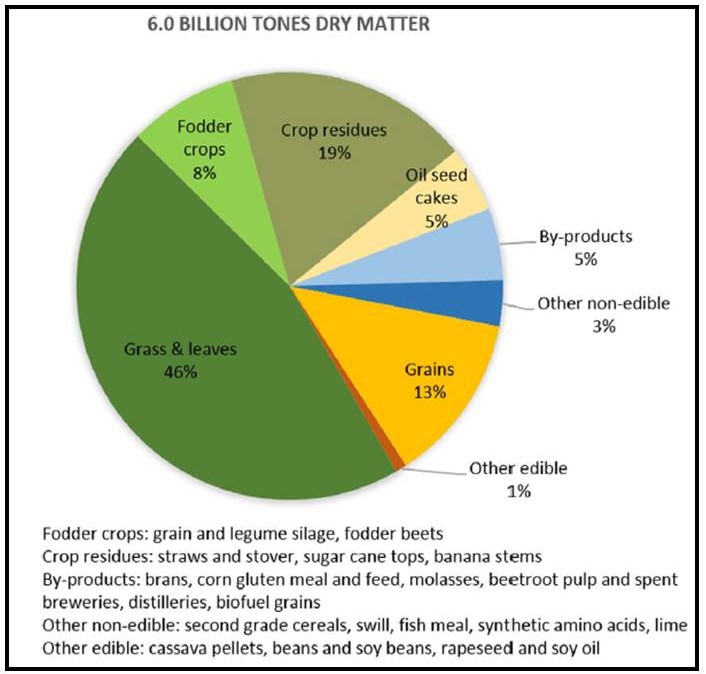
Another important point highlighted in this paper is the capacity of ruminant livestock in particular to utilise plant bi-products from the human food processing sector, as well as grains unsuitable for human food processing due to factors such as weather damage.
“Today, crop production, processing and the agrifood chains produce large amounts of residues as well as co- and by–products, which constitute nearly 30% of global livestock feed intake. These products will be produced in larger amounts as the human population grows and consumes always more processed food. Livestock play, and will continue to play a critical role in adding value to these residual products, a large share of which could otherwise be an environmental burden.”
Figure 3: While beef cattle finished in feedlots are fed rations containing grains, most are varieties unsuitable for human food or downgraded grains, and they are often mixed with bi-products from food processing which would otherwise present a disposal problem. Photo: Patrick Francis.
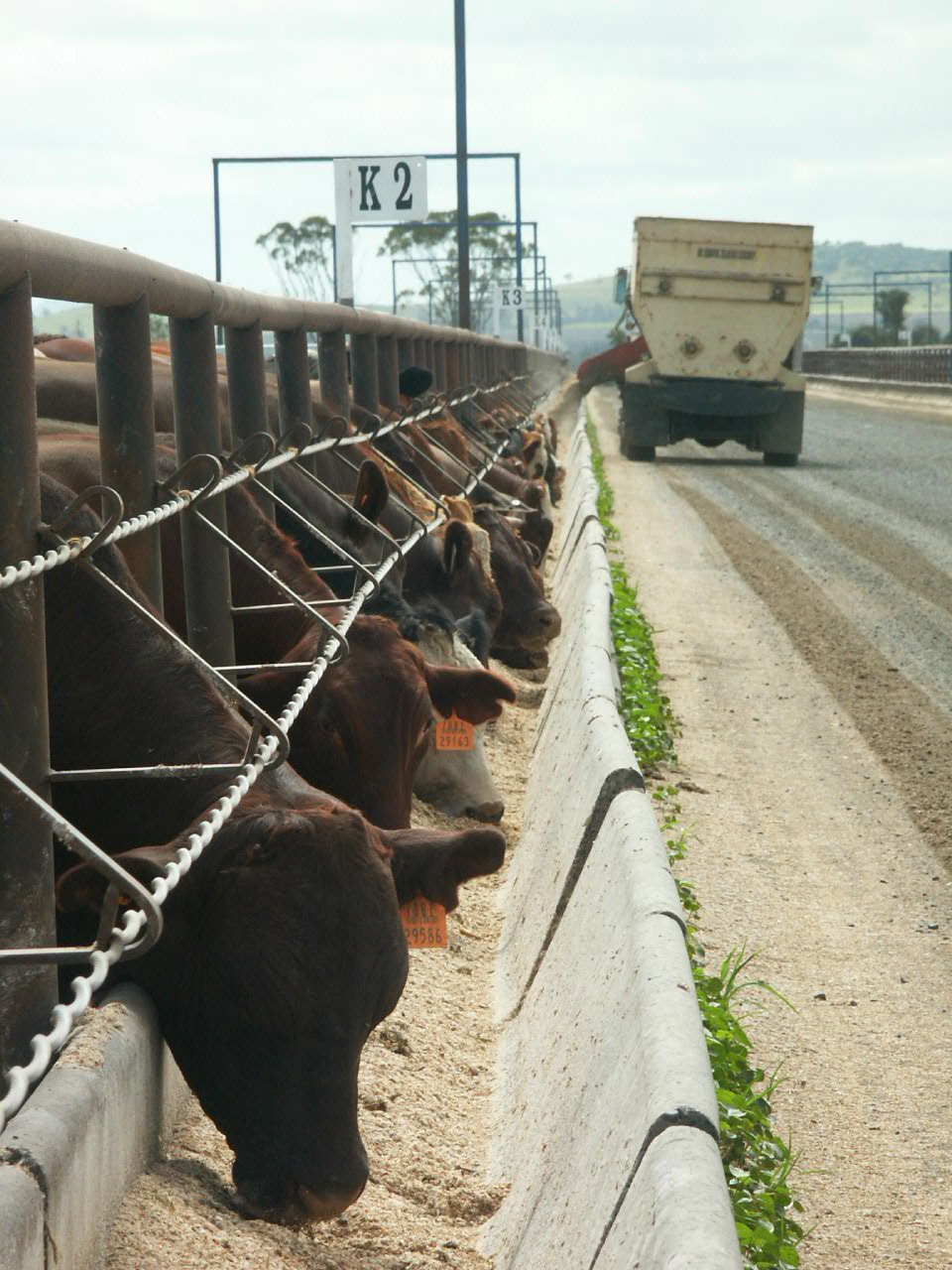
The diversity of food processing bi-products consumed by beef cattle which would otherwise be sent to landfill is demonstrated in Australian drought feeding literature. For instance, the 1997 Beefline “Drought management package” lists under suitable miscellaneous feedstocks: apple pulp, carrots, citrus pulp, cotton gin trash, grape marc, peanut hulls, sunflower hulls, brewers grains (sprouted barley from beer manufacture principally fed to dairy cows), corn gluten meal, oat hulls, and rice hulls.
The report authors highlight that as well as consuming residues, damaged or unusable foods and bi-products all livestock make an indirect contribution to soil health through manure thereby increasing crop productivity.
“In Europe, the share of manure in total nitrogen inputs was estimated at 38% and as much as 61% in the Netherlands.”
In Australia cattle feedlot manure composting is an important subsidiary business with the output being used as a nutrient and soil health improver on cereal crops, pastures and in horticulture. Monogastric livestock manures (fresh and composted) are also widely sought after by farmers. These livestock manures are replacing inorganic (chemical) fertilisers for nutrients as well as adding organic carbon to soil and increasing grain and pasture yields per hectare. The latest data from Australian Bureau of Statistics shows that in the 12 months ending 30 June 2013, Australian farmers spread 1.2 million tonnes of livestock manures compared with 1.1 million tonnes of urea (approximately 550,000 tonnes of nitrogen) and 892,000 tonnes of ammonium phosphates.
Figure 4: Livestock manures from intensive livestock feeding businesses are being increasingly used by crop and pasture farmers in OECD countries as fertiliser and soil health ameliorants due to their high organic carbon content and extensive organic nutrients composition.
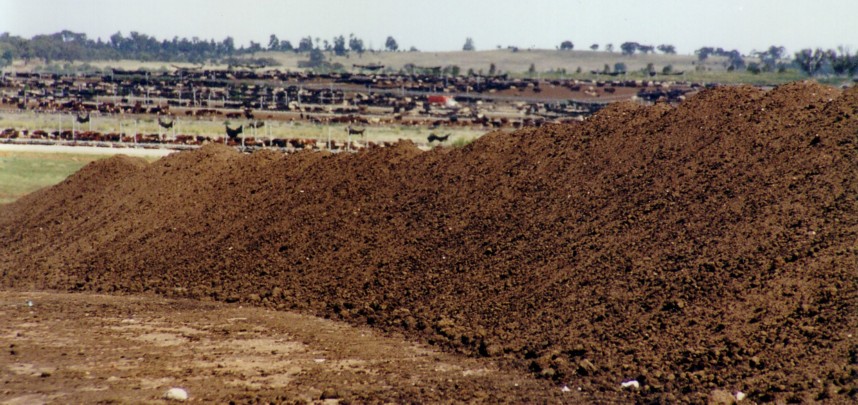
The authors acknowledge another critical point about why livestock are important in the world’s grain industry and that is helping to keep a balance in supply and demand. Without some grain being traded and consumed as livestock feed, world supply would significantly outpace demand leading to stockpiles and lower prices for farmers worldwide. Figure 5 and Table 3 show how finely balanced world grain production and use is. It highlights how total grain production is increasing world-wide in conjunction with increasing demand for food and livestock feed. Importantly it shows world year ending grain stocks are on an increasing trend. Reduced grain utilisation by livestock would increase stocks.
Figure 5: Trends in world grain production, utilisation and stocks.
Source: International Grains Council 2017
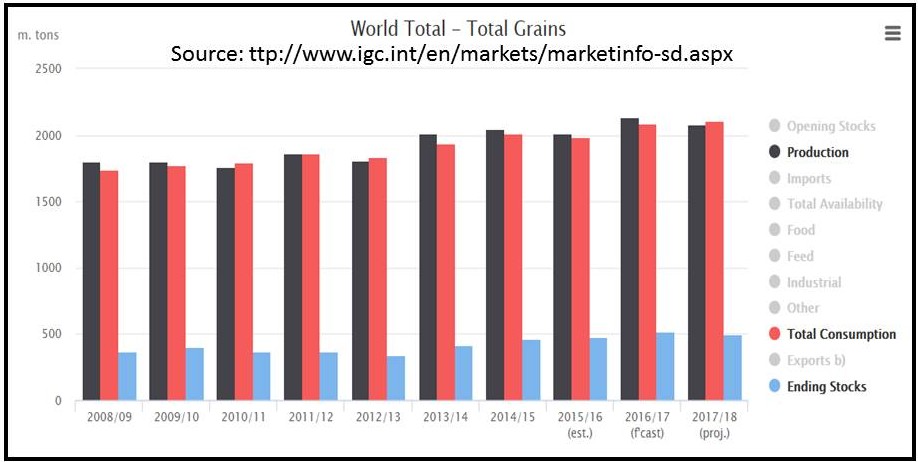
Table 3: Trends in world grain production, utilisation and stocks.
Source: International Grains Council 2017
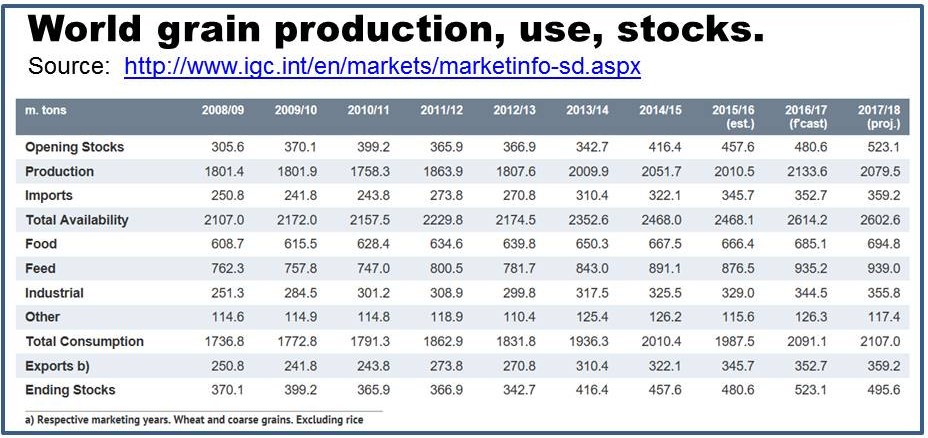
If stockpiles build there is danger that they could suffer significant deterioration during storage in food value and quality with potential for increasing amounts shifting into livestock feed only categories. The temptation to avoid this happening could see grain dumping into developing countries which could devastate small holder farming viability. Mottet et al contend that understanding this issue requires a different modelling framework to the one they used in their analysis and so it is not explained in their report.
Land use implications
Apart from determining that livestock are not a major threat to human food availability the study investigated future farm land requirements for growing crops. This part of the analysis is somewhat confusing and to a large extent academic as it is difficult on a world scale to distinguish between farmland used for grazing alone, grazing with cropping and cropping alone.
How difficult this is can be illustrated from experience in western Victoria’s high rainfall zone and central/western NSW low rainfall zone. Twenty years ago both areas were considered as predominantly livestock grazing regions, but today many districts are dominated by cropping. This has come about with the introduction of more suitable crop varieties, machinery technology advances that enable environmentally safe, low cost sowing into challenging soils, and crop monitoring technology which optimises yields around soil moisture content, soil fertility and soil health.
Over the same time livestock productivity has been improving due to breed genetic improvements, providing higher quality feed which improves feed conversion ratios (FCRs) and fertility, and improved livestock health. Livestock genetic improvement means that in many countries livestock breeder numbers have remained static for many years but total meat and milk output has increased significantly.
The study models the impact of improved FCRs on land use with the message being that if FCRs can be improved particularly in non-OECD countries where they are presently low, future land requirements for increased livestock production will be curtailed.
“Given the OECD-FAO Agricultural Outlook projections in crop yields for 2025, the area necessary to produce the required human edible feed materials in non-OECD countries is expected to decrease by 4–10% between 2010 and 2025, depending on the FCR improvement scenario. In OECD countries, it is expected to decrease by 4% or increase by 1% depending on FCR improvement scenario.”
Food aid and malnutrition
The food shortages which happen in different countries around the world causing malnutrition in approximately 800 million people are not a consequence of livestock being fed grains. They have multiple and complex causes relating to politics, human rights, religions, land tenure, climate change, education and women’s rights, unemployment, food storage and processing infrastructure, and transport logistics.
The 2017 FAO report “How close are we to zero hunger?” states: “Of the 815 million chronically food-insecure and malnourished people in the world, the vast majority – 489 million –live in countries affected by conflict.”
This report says conflicts within and between countries have increased since 2010. It gives examples of how regions within countries which were pre-conflict, significant cereal grain producers must now import grain or be given food aid.
“On average, 56 percent of the population in countries affected by conflict live in rural areas, where livelihoods largely depend on agriculture. Conflict negatively affects almost every aspect of agriculture and food systems, from production, harvesting, processing and transport to input supply, financing and marketing. In many countries affected by conflict, subsistence agriculture is still central to food security for much of the population. In Iraq, for instance, before the conflict, the Ninewa and Salah al-Din districts produced almost one-third of the country’s wheat and nearly 40 percent of its barley. An assessment in February 2016 found that 70-80 percent of corn, wheat and barley cultivations were damaged or destroyed in Salah al-Din, while in Ninewa 32-68 percent of land normally used for wheat cultivation was either compromised or destroyed, as was 43-57 percent of the barley cultivation.”
The FAO report provides numerous examples of how improving social structures around agriculture within conflict zones can help restore peace:
“As many ex-combatants are young men and women from rural areas, enhancing skills and providing capital for agricultural livelihoods is as important for food security and income as it is for a more positive outlook. The agriculture-based Ex-Combatant Reintegration in Liberia programme provided participants with meals, clothing, basic medical care and personal items, as well as training and agricultural tools and supplies. An evaluation showed the programme led to the increased engagement of youth in agriculture.
“The PBF–FAO–ILO Jobs for Peace programme implemented in the insurgency-affected areas of Nepal in the period 2009–2012 was the creation of rural youth employment. It played an important role in enhancing social cohesion during the post-conflict process of reintegration and sustaining peace, providing remunerative alternatives and discouraging re-engagement in violence.”
Grain aid balance
Most of the grain that could potentially shift out of animal feeding into the human food chain is grown mainly in four OECD grain exporting countries plus former Soviet Union countries. Even if an additional 20% (to existing food aid programs) was donated as food aid the volume delivered would most likely devastate local small holder economies and much of it could be degraded during transport and storage.
It is why most politically stable developing African and Asian countries prefer to boost domestic production using technical and financial support from developed countries. This situation is summed up by president of the African Development Bank Dr Akinwumi A. Adesina at the launch of Feed Africa – strategy for agricultural transformation in Africa 2016 to 2025:
“It is time for Africa to feed itself. There is no reason for Africa to be a net food importing region, spending $35 billion annually on food imports. This is especially so because the continent has 65% of the uncultivated arable land left in the world to feed 9 billion people by 2050. What we do with African agriculture today will determine the future of food in the world.”
Figure 6: Outside of conflict zones developing nations’ governments are putting in place programs to ensure future food self-sufficiency generated by small holder farmers using overseas investment and technical support rather than relying on food imports or aid. Photo: Imperial College London.
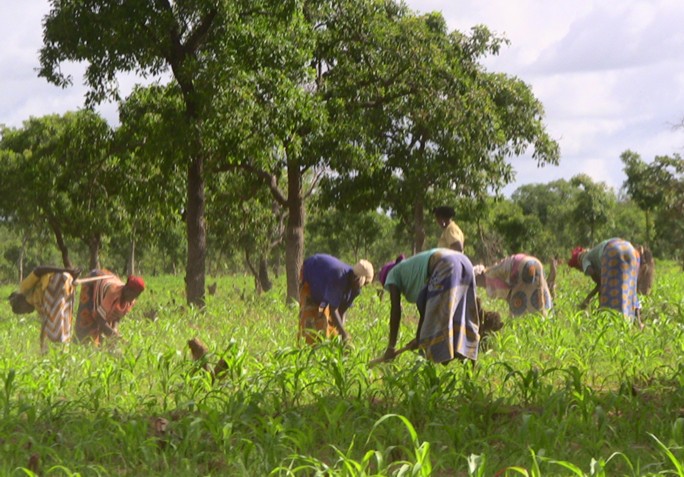
Another important issue to understand in the feed versus food debate is the roll of livestock as part of human nutrition world-wide. Motet et all summarise the contribution:
“Food from animal sources contributes 18% of global calories (kcal) consumption and 25% of global protein consumption (FAOSTAT, 2016). But it also makes an important contribution to food security through the provision of high-quality protein and a variety of micronutrients – e.g. vitamin A, vitamin B-12, riboflavin, calcium, iron and zinc – that can be locally difficult to obtain in adequate quantities from plant-source foods alone.”
Where food aid is needed to prevent malnutrition its usefulness is not a matter of just sending more grain from exporting nations such as Australia and the US where corn and wheat are in surplus. A report by Laura McCullagh in the Medicines Sans Frontiers Australia newsletter in June 2010 described why:
“For many years food aid for children has consisted largely of corn or wheat/soy blended porridge, the ingredients of which can inhibit absorption of essential minerals such as zinc which are vital to childhood development and survival. These enriched flours also have none of the animal-source protein that is important for growing children. This means that with the traditional food aid, children might receive sufficient quantity and calories but would still remain at high risk of impaired growth and development due to the inadequate quality of the food provided…..The World Food Program is now adopting a new nutrition strategy…including new products with animal source protein for children under two years of age.”
Grains aren’t grains
The importance of food quality for undernourished people has a related dimension which is the relationship between grains available to be used as food aid and their inherent biochemical characteristics to produce food that different communities are used to eating. Just like “oils aren’t oils” “grains aren’t grains”.
Wheat Quality Australia describes grain quality as “the performance of grain to meet the requirements of its use in flour milling, breads, noodles, cereals, pasta or animal feed. Quality is determined by the genetic attributes of the variety grown and the environmental conditions during crop growth. … The quality of Australian wheat varieties must first be determined through a classification process to ensure every variety of wheat in a class meets the requirements needed for specific use.”
There are nine classes of Australian wheat which are split into three key categories: Premium Hard Wheats, Multi-Purpose Wheats and Specialty Wheats. There are approximately 180 wheat varieties on the Wheat Quality Australia Final 2017/18 Wheat Variety Master List which growers can use. Out of these, 21 varieties (11.6%) are classified as “feed” wheat in all four Australian growing zones.
With such variety end-use complexity associated with all major grain types available for export and food aid the notion of deliberately switching more grains from feed markets into food markets makes no sense. Variable environmental conditions each year in every grain exporting country will guarantee a proportion of food grade grains must be transferred into the feed or industrial grade markets.
On top of this humans use different grain types as staple foods – some have grain diets based on pulses or rice or corn/soybeans or wheat. With long-held food consumption customs and traditions interchanging grain staples is not feasible. Even within a particular grain type, varieties must be suitable to meet particular ethnic requirements. For instance Australian wheat varieties and blends are capable of the following end uses:
• All types of Asian noodles, including udon, ramen and instant noodles
• Asian steamed products
• Asian-style bread
• Western-style bread
• Middle Eastern and Indian style bread
• Sweet cakes, pastries and confectionary
• Pasta and cous cous
Figure 7: A grain shortage in one developing country cannot be simply rectified by shipping any surplus grain from an exporting nation such as Australia or Canada because the grain type might not be appropriate for local consumers.
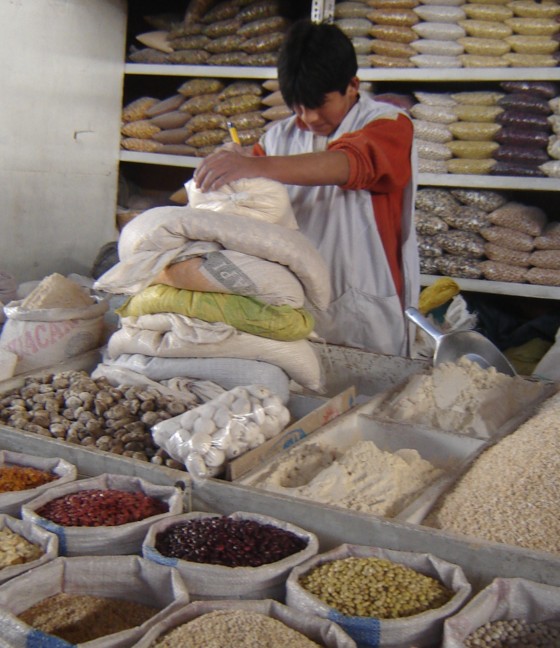
Take home message
A world analysis of the feed consumption of all livestock classes shows that the bulk of their diets are supplied by pasture, browse, food processing wastes and bi-products. Just 13% is supplied by grains that could be used for human food production. Altering this percentage is not feasible as across all grain types each year a proportion fall into feed grade due to seasonal environmental conditions. As well, different ethnic populations do not readily interchange staple grains based food. So shifting excesses of grain types between exporting countries to meet local shortages does not necessarily follow. Such a strategy also threatens the viability of small holder farming in developing countries.
The world grains production is increasing in line with increasing consumption enabling year ending stocks to be maintained. Feed grain trade is an important component of balanced grain use to meet growing human demand for livestock protein in particular that produced by monogastric livestock such as poultry and pigs.
Ruminant livestock produce a higher value meat demanded by the growing middle income population in developing countries. While ruminants eat some food grains the majority of their diet in intensive production units is based on feed grade grains, and herbage. As well, there is an increasing trend amongst middle income consumers to purchase ruminant meats from livestock fed solely on pasture with quality assurance and organic certification used to verify such undertaking.
While in some countries human malnourishment continues, the world’s exporting countries have sufficient grains available for food aid. Most of the mal nourishment is occurring in conflict zones which have been increasing in developing countries since 2010. Outside of conflict zones, governments are looking for food self-sufficiency rather than aid as the medium-term solution for preventing mal-nutrition and increasing their populations prosperity and environmental resilience.
Figure 8: There is increasing demand amongst higher income consumers in developed nations for ruminant meat bred, reared and finished on pasture without any grain supplementation. This is demonstrated by the growth in demand for certified organic beef and lamb and retail brands for certified pasture fed red meats. Photo: Patrick Francis.
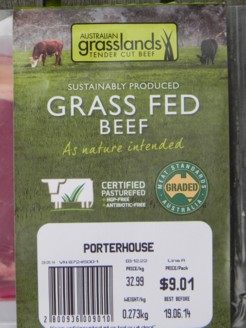
Further reading:
“Livestock: On our plates or eating at our table? A new analysis of the feed/food debate” http://www.sciencedirect.com/science/article/pii/S2211912416300013?via%3Dihub
FAO food security summary report: http://www.fao.org/state-of-food-security-nutrition/en/
FAO food security full report http://www.fao.org/3/a-I7695e.pdf
Feed Africa full report https://www.afdb.org/fileadmin/uploads/afdb/Documents/Generic-Documents/Feed_Africa-_Strategy_for_Agricultural_Transformation_in_Africa_2016-2025.pdf
Feed Africa summary report https://www.afdb.org/fileadmin/uploads/afdb/Documents/Policy-Documents/Feed_Africa-Strategy-En.pdf

